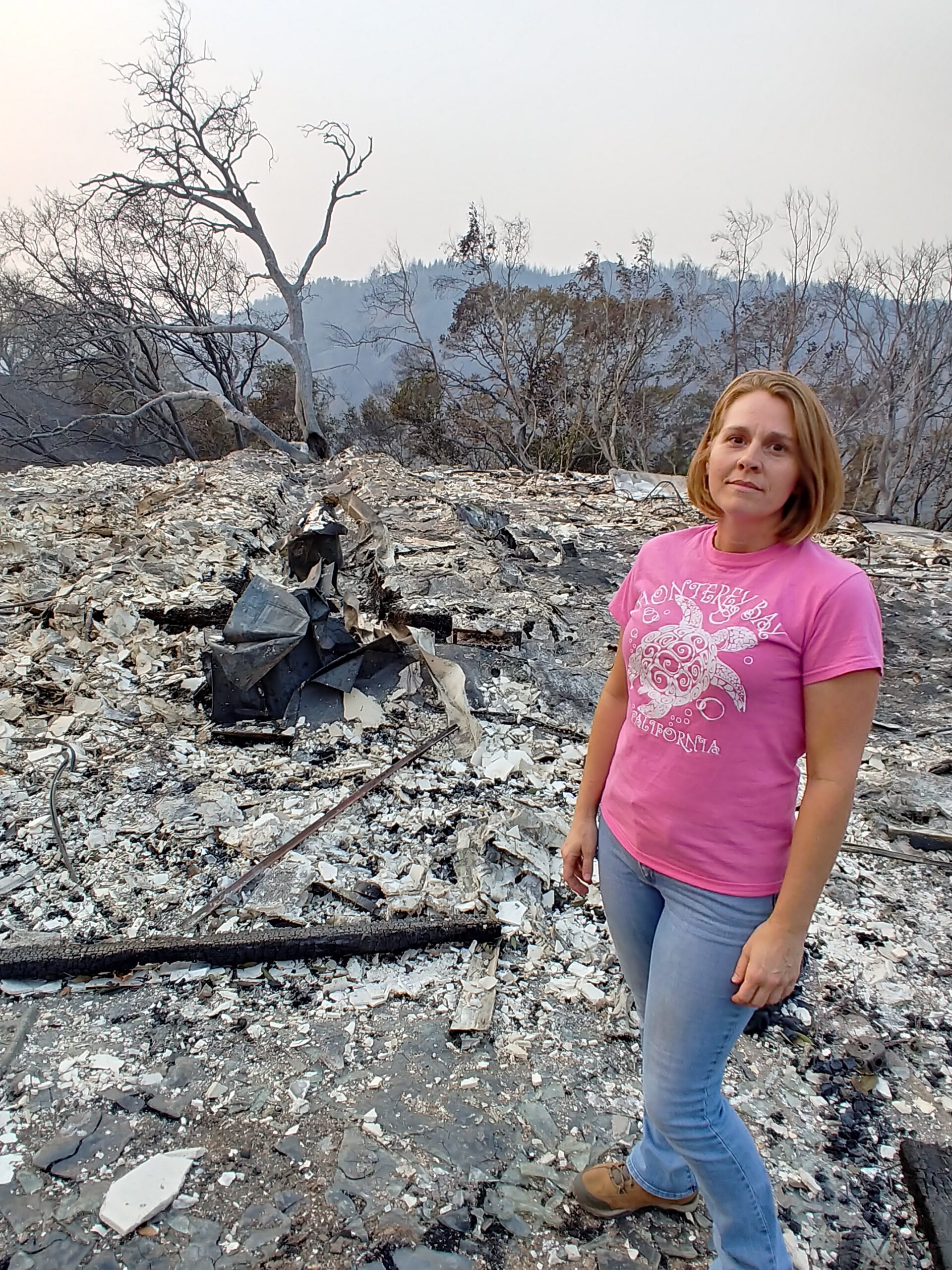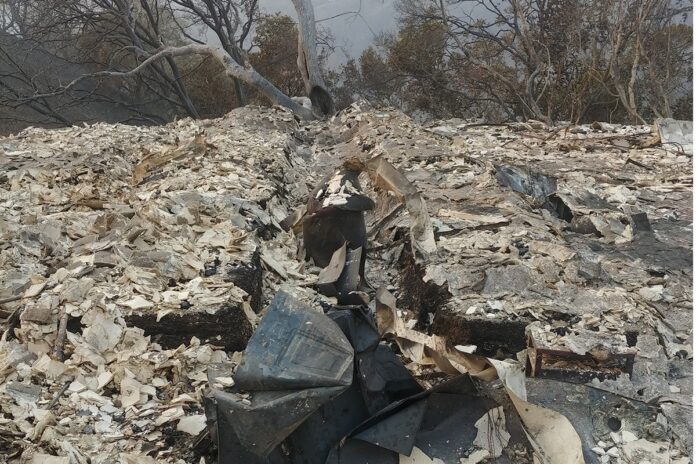SONOMA COUNTY, Calif. – It’s difficult to comprehend how quickly and completely a big fire can wreak havoc when it sweeps across drought-affected terrain where bark beetles already have ravaged old-growth forests and the hills, foothills, and meadows are golden brown with tinder dry shrubs and grasses.
Ask Lisa Lai about wildfires. She co-owns an organic cannabis growing facility named All Cali Farms that was founded in 2017 in the hills overlooking Sonoma County in Northern California. The farm was decimated by the Glass fire in October.
“This fire was so hot and fast that it burned down thirteen wineries, even ones surrounded by vineyards. The vineyards usually are really great firebreak, but the fire was so hot that they just couldn’t stop it,” Lai described to mg. “We had 100 percent loss. The barn burned to the ground, along with all of our equity and plants. Our wells were damaged, we lost our outbuilding, our water tank, and even my beloved honeybees.”
Perhaps, not surprisingly, it wasn’t her first experience with out-of-control wildfires.
“We were in the corridor between the two large fires in Sonoma County in 2017. So, we had dealt with extended evacuations and power outages, but this is the first time our property burned,” she said.
As students at Humboldt State University in 2003, Lai and her partner learned craft cannabis farming there. Avid hobbyists who blossomed into expert growers, they specialized in organic indoor flower. After a move to the Bay Area for employment, the couple maintained deep roots in the legendary wine country and continued to pursue expanded cultivation facilities.
“We had previously always grown at our primary residence and had a collective,” said Lai. “Our home was ineligible for a permit in the newly regulated market because we were in a neighborhood. We were able to qualify for a program called ‘penalty relief’ because we are legacy growers, meaning we had already been growers before rule changes. So, we’d been lucky enough to get local approval to continue to grow through our county permitting process.
“It was a dream come true to have a commercial farm,” she continued. “We have been in the permitting process in Sonoma County for three years. It’s a long and arduous process, but we were lucky. We were able to move forward with our dream. Many legacy farmers were not able to transition to the legal market because the bar for entry was set so high.
“I was lucky to find a property—although not ideal in hindsight—that I could afford. I have wonderful neighbors that have really let me become a part of their community,” Lai said.
“We didn’t live on our farm. The property we purchased only had an agricultural barn on it, not a home. For a long time that felt like a weakness of our property, but in hindsight we feel very lucky to still have our home.”

Lai recalled how the Glass fire not only burned down All Cali Farms but also residences nearby. Her description of the event conveys the sense of helplessness felt by wild fire victims, as well as the horror of having watched the fire’s progress, in real time, on security cameras.
The day started like any Sunday, she explained:
“I wake up early on Sunday mornings and go for a bike ride with a friend. The fire was in Napa at that point and we didn’t think it could come get us. It would have to turn into a huge fire to do so, and the firefighters were already battling it. So, we really thought we were safe.
“But that evening around 8 p.m., I got a call from a neighbor who is also in the industry. I was already at home for the evening at that point. She told me that a spot fire had started pretty close to us. It was really windy. I alerted our other neighbors.
“I watched on my cameras as the neighbor that lived past me got out safely. I was really worried about him because he didn’t have a cell phone and said that he hadn’t heard about the fire yet. There were no evacuation orders yet anyway.
“He later credited me with saving his life. By the time he got past my property and onto the county road, the fire was burning on both sides already. His cottage burned to the ground. He had lived there for nearly forty years.
“By 10:00 p.m., the other cannabis farmer that lives by my farm told me that everything was gone. He lost his home and his farm, along with three of his animals that he was unable to evacuate. Thankfully, his family all made it out alive.
“The woman who had originally alerted me to the fire did a live Facebook stream as she evacuated; she wasn’t driving. The fire was clearly burning during her evacuation and was already very large. There were several spot fires that started all at the same time. She ended up losing her property, along with the equipment she uses for her profession, and her beloved chickens.
“The rancher up there, who has had the property in his family since the 1800s, is sort of our local ‘mayor.’ He was able to save his home and all of his cows survived! His sister and her husband also saved their home. His granddaughter and her family, were able to safely evacuate. They lived in one of the rancher’s homes that burned and lost all of their belongings. His other rental burned as well.
“My cameras went black before I saw the fire on them, when the power went down. So, we held out hope that our property had been spared. We had spent the last three years lolly-popping trees and removing brush, preparing for just such a situation. PG&E [utility company Pacific Gas and Electric] had even removed fourteen trees from right behind the barn, under the power wires.
“But we got confirmation by the afternoon, on Monday, that it had burned to the ground,” Lai concluded her story.
The Glass fire, which started September 27, eventually burned 67,484 acres in Napa and Sonoma Counties and was fully contained on October 20.
All gone in a matter of hours—All Cali Farms and its neighboring properties had been consumed, not to mention the damage done to the hard work and memories, hopes, and dreams.

If facing a total loss weren’t tragic enough, insult is added to injury when one understands that legal cannabis businesses must go without conventional business insurance coverage, due to continued federal prohibition. Because cannabis is still classified as an illicit substance by the Controlled Substances Act, it’s considered illegal by federal agencies including the Drug Enforcement Administration and the Food and Drug Administration. Legal cannabis businesses are unable to access conventional business banking and financial services for the same reason, and despite state legalization.
The outdated policies mean legal cannabis businesses have no options for federal disaster relief. In a year like 2020, which is unprecedented on the disaster front, governmental agencies are overwhelmed and stretched thin; even if economic aid for cannabis farmers were made available, it might not come any time soon for the fledgling industry.
Hemp growers are an exception after hemp cultivation was legalized by the passage of the 2018 Farm Act. Hemp farmers can apply to the U.S. Department of Agriculture (USDA) for financial relief due to hardships caused by the pandemic or natural disasters. President Donald Trump and U.S. Secretary of Agriculture Sonny Perdue announced the second round of the USDA’s Farm Service Agency’s Coronavirus Food Assistance Program relief on September 18.
“Although we tried to get insurance for three years, we had a difficult time getting insured due to the fact that we were not able to pull permits during our cannabis permitting process. So, we were unable to do the upgrades the insurance companies wanted us to do. We were just waiting it out until we had final approval to expand from the county,” Lai explained.
“Disaster relief is for primary residences. It looks like cleanup is going to come out of pocket for us. I’m a member of the Hessel Grange and they are offering to help me with cleanup. So we will see what that looks like; there are some legal hurdles to jump here. You can’t just go out and clean up your own property without proper permits and testing. We are at the very beginning of all of that still,” she said.
Hessel Grange is the first hemp and cannabis Grange in the country, according to Lai. New to cannabis but having existed for many years, Hessel Grange is affiliated with The National Grange of the Order of Patrons of Husbandry, a national association of farmers that was established in 1867.
Lai said members of Hessell Grange and the organization will help. “We’ve had an amazing outpouring of love and support from our community.
“We are so thankful for everyone who has donated to us or reached out for emotional support. We are counting our blessings and looking for the silver lining. If anyone would like to help us out with a donation, please, come find us on Instagram @allcalifarms,” Lai added.
As terrible as the devastation is on a personal level for Lai and every cannabis farmer who has been affected by wildfires, those are not the only challenges facing the industry. Political concerns, public health, and social justice firestorms are blazing in America and have changed life fundamentally.
On a local level, Lai said that in response to the historic fires, the California State Board of Forestry is hoping to change fire safety ordinances so that all roads in the area would be widen to at least twenty feet, to accommodate evacuations and firefighting vehicles.
Lai fears the cost of improvements would fall on local farmers (of various crops) who already have taken a tremendous financial hit after years of fires, on top of a pandemic-induced decrease in tourism and retail sales.
“Cannabis farms in Humboldt, Trinity, Mendocino, Sonoma, and Lake counties will all be negatively impacted,” she warned. “If you care about those farmers (or are one of them), please, make your voice heard at the Board of Forestry and ask them to exempt cannabis farms the same way they do other agricultural [entities].”
On a personal level, Lai is resilient. “I have not given up on my dream yet. We are definitely planning on rebuilding. We are still on track with our permits through the county. Unfortunately now, instead of remodeling our barn we’ll have to build it from the ground up. And we have lost our income for the property. So, our path is still unsure and rocky.”










